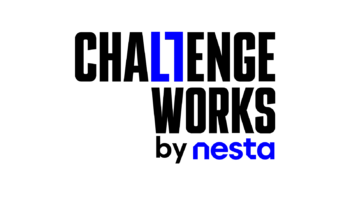News – Blog
Our favourite tried and tested workshop resources
16 March 2022
- Catherine Thompson
We’ve collated our favourite techniques and tools which help us facilitate engaging and productive workshops, to help you get the best out of your participants during such sessions.
Between the sessions we run with partners to explore potential Challenge prizes through to the some of the non-financial support sessions we include in many of our programmes, here at Challenge Works we end up facilitating quite a lot of workshops.
We recently caught up internally to compare notes about some of our best facilitation tips and tricks, and we thought we’d share with you eight of some of our favourite workshop resources.
1. Inclusive Icebreakers
We love this blog from Lizzie Cass-Maran to help explain the importance of inclusive icebreakers. In her blog she digs into a couple of examples of common icebreakers and alternatives that are more inclusive; once you understand the importance of inclusive icebreakers this guide from Stonehill College at MIT gives you way more examples.
Quite a few of these are a little education-specific but there are also some which can be really helpful if you’re looking to help build strong teams or get to know each other quickly – a couple of favourites in there include the ever-popular Human Bingo and Whose story is it – which is a bit of a twist on Two Truths and a Lie.
2. Virtual Energizers
Over the past 24 months, we’ve been getting creative having an energizer at the beginning of each of our team meetings. There are a couple that it’s obvious a lot of the team enjoy:
- Portrait camouflage The facilitator picks a famous portrait (Think the girl with the pearl earring, Mona Lisa or one of Picasso’s finest) and then gives everyone 2-5 minutes to look as much like that person as possible. Cue creative crafts, scavenging or digital adaptations as everyone hurries to look most like the portrait. Make sure to pick a winner (or two). If you’ve got a team with a lot of pets, be sure to pick a portrait with an animal in it.
- Will it float? Pretty random one, and requires quite a lot of prep. One person needs a load of household items and water that is deep enough to fully submerge everything there – think kitchen sink or a washing up bowl. Everyone votes on if each item will float or not – and at the end, the person with the most correct answers wins!
- How many uses for a ______? Really good as a creativity workshop warm-up, pick a random (and multi-use) item – like a brick, a cotton bud, blu-tak, gaffa tape and then ask everyone to write down as many ways to use it as possible in 60 seconds. Get people to share how many thought of and explain all the uses. This one also works in person.
3. Bad Ideas Workshop
One we have shamelessly stolen from the fab Nesta Discovery team is a Bad Ideas Workshop, based on this HBR article by Ayse Birsel. It’s a lot of fun and can really help you avoid getting stuck in group-think and letting your assumptions guide potential solutions to a problem by opening up your horizons. It’s also a good one for when you actually are stuck or out of ideas.
The way we’ll now use this one is:
we’ll explore all the possible bad ideas we can think of in 10 minutes (using words like unethical, impossible (or even evil) to get people’s creativity flowing)
Then we’ll pick a couple of favourites and explore:
- What makes them bad (which will help us understand when we have found a good idea because it won’t have that feature);
- What insights we can gain from that bad idea
- Some potentially good ideas based on those insights.
4. Personas workshop
When you’re trying to dig into or understand a problem with a new group of people, we’ve found a personas workshop really helpful to understand problems from different perspectives. Nesta have a handy persona toolkit to get you started. Typically we’ll customise this to focus on the problem at hand.
First, in groups we’ll create our imaginary person (or organisation) – giving them habits and talking about their favourite breakfast or if it’s an organisation, the kind of office party they have. We sometimes draw the person/organisation too. It really helps people to switch mindset and see things from a new perspective.
Once we’re all imagining the person, then we dig into the problem a bit more and think through the current issues that person is facing and also what the ‘ideal’ might look like from them. If you’re used to creating user stories in agile, think as this as a ‘level above’ thinking about the person/user as a whole rather than focusing on specific journeys.
5. Other useful Nesta Resources
Nesta has some created some really useful templates and resources over the years. Sometimes they can be a bit hidden so here are some direct links:
Development Impact & You (DIY Toolkit)
This was developed to support international development – but it has a range of tools you can use to:
- Look ahead
- Develop a clear plan
- Clarify priorities
- Collect input from others
- Get to know people
- Generate new ideas
- Test & improve what you’re doing
- Sustain & implement change
Originally developed to support people to create creative hubs, this resource is packed full of useful approaches to support you to launch something new. For example this includes some useful tools to:
- Carry out stakeholder mapping
- Develop personas
- Build a persuasive story
There are also quite a few standalone worksheets:
Explore many more tools in the Nesta toolkits section.
